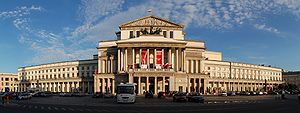
Theatre Square (Warsaw)
Encyclopedia

Warsaw
Warsaw is the capital and largest city of Poland. It is located on the Vistula River, roughly from the Baltic Sea and from the Carpathian Mountains. Its population in 2010 was estimated at 1,716,855 residents with a greater metropolitan area of 2,631,902 residents, making Warsaw the 10th most...
, Poland
Poland
Poland , officially the Republic of Poland , is a country in Central Europe bordered by Germany to the west; the Czech Republic and Slovakia to the south; Ukraine, Belarus and Lithuania to the east; and the Baltic Sea and Kaliningrad Oblast, a Russian exclave, to the north...
. It spans from the Great Theatre building to the Senatorska Street.
The origins of the square date back to the beginning of the 19th century, when a small square was established in 1818. In 1825-1832 the Great Theatre building was constructed. When the city administration was relocated to the Jabłonowski Palace
Jabłonowski Palace
Jabłonowski Palace is a historical palace at the Theatre Square in the Śródmieście district of Warsaw, Poland. Before World War II it served as the city hall of Warsaw.-History:...
, the square became a centre of city life. Various patriotic demonstrations took place there, including at the time of the January Uprising
January Uprising
The January Uprising was an uprising in the former Polish-Lithuanian Commonwealth against the Russian Empire...
and the Revolution of 1905. Both demonstrations were bloodily crushed by Russian authorities. In September 1939 the civilian defense of the city was located in the city hall. During the Warsaw Uprising
Warsaw Uprising
The Warsaw Uprising was a major World War II operation by the Polish resistance Home Army , to liberate Warsaw from Nazi Germany. The rebellion was timed to coincide with the Soviet Union's Red Army approaching the eastern suburbs of the city and the retreat of German forces...
of 1944 the square witnessed heavy fighting between the Nazi German soldiers and the Armia Krajowa
Armia Krajowa
The Armia Krajowa , or Home Army, was the dominant Polish resistance movement in World War II German-occupied Poland. It was formed in February 1942 from the Związek Walki Zbrojnej . Over the next two years, it absorbed most other Polish underground forces...
partisans. Most of the surrounding buildings were heavily damaged or completely destroyed. After the war several buildings were renovated, though the pre-war city hall was not. In the 1990s it was built again according to original architectural plans.
Landmarks on the square include the Great Theatre, Jabłonowski Palace, Blank Palace, Saints Albert and Andrew Church, several old tenement houses and statues.

